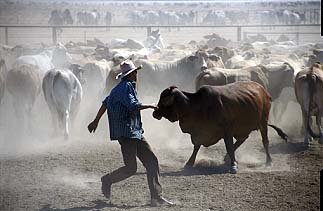One of the more rewarding jobs I’m asked to undertake for producers is to select their replacement females. The rewards for this job come in various ways. Firstly it’s great to be trusted to make decisions that will impact on the long-term direction of a herd. Secondly, I find a great deal of satisfaction in participating in a process that has a direct impact on the financial returns from a breeding herd, not to mention influencing the overall productivity of that herd.
I’m often surprised in the way many producers approach selection. I often encounter herds that have only one criteria for selection, which is that cows must have a calf every year. Now there’s certainly nothing wrong with this criteria. But that’s only one area to consider.
So what should you consider during selection?
Structure
Structural soundness is fundamental in a herd. The ability of your cattle to walk and forage directly impacts on their individual performance and on your herd’s productivity. Cattle that have poor leg structure suffer from arthritis; are prone to lameness and find walking distances to access feed and water more difficult, especially as they get older.
The flow on effect of this is a reduction in the ability of individual cows to meet their feed demands for maintenance, growth and production. Cows with a lower condition score at calving take longer to start cycling again. A late cycle puts the cow further behind in calving, and this cascades to a point where she may have only cycled once in the 12 week joining period.
Her ability to deliver a calf unassisted is also impacted on by structure. The angle between her pins and hips has a direct influence on calving ease, as does the width between her pins.
Teat size and udder structure are also important in the structural assessment process. Achieving the genetic potential of your calves to gain weight to weaning is greatly dependent on the cows milk supply. Poor udder attachment, badly sized teats are common causes of everything from poor suckling to mastitis and reduced milk production.
Maturity Pattern
Maturity pattern should be a focus in selection. In the back of your mind you need to consider if the cattle you are producing will have the right level of fatness for your target markets. But you also need to think about the cows and their energy demands. Larger framed, later maturity cows require more feed, and if you don’t have the feed to met those demands you will either have lower fertility levels, or you will have to run less cows.
It’s equally important to have an even group of cows. Evenness will help you manage feed supply to your cows more effectively. You will find the process of managing joining and calving more efficient than if you are trying to juggle the different needs of big and little cows.
Lets not forget that having a range of cow sizes will also mean a range of weaner sizes. If you are trying to manage for a drought, not to mention hit a specific turn off time or weight, various sized weaners will cause you no end of headaches.
The Other Traits
Temperament is one of the most important traits to select for. I really don’t like cranky cows, flighty cows, or those cows you just can’t trust! Selecting out the quieter, less nervous cattle will improve your handling experiences, for both you and your cattle!
And never forget that quiet cattle produce a quieter calf. This in turn that is directly related to their eventual eating quality.
I also use the time to select for those cattle that have the traits that add value to your turn off. I try and select cattle that have superior growth for age (within the maturity pattern suitable for the area), and for cattle that display a higher degree of muscularity.
Can you put a price on it?
Its actually not that hard to put a price on the benefits of improved selection. Not so long ago I ran a comparison on a clients herd. I looked at the impact selection had when we changed operations to keep cows in the herd for 2 more years, and to tighten calving from 16 weeks to 12 weeks.
Focusing on an early maturity pattern did help us tighten joining. We also managed nutrition more effectively during joining so that the cows were on a rising plane of nutrition.
These changes impacted a number of areas across the herd. It changed the number of replacement heifers we were keeping, changed the age structure slightly in the cow herd, and changed the value of the weaners being sold. The value story was interesting as this was the influence of having a greater number of cattle at a similar age and weight, rather than smaller numbers across a couple of different weight categories.
When we I ran the numbers I found we had actually increased the gross margin by 19%! That was a huge lift in productivity and profitability, and we really hadn’t done anything other than change some selection criteria.
Now this was a pretty big shift, and I reckon not everyone will get a huge lift. Although there are gains to be made trough the sale of more surplus females, tightened joining, improved time management and so on.
Ultimately I reckon it proves that focusing on these traits is financially worth doing. And as someone who enjoys doing this work, I’ll always be happy to come and do it for breeders. Its one job I know more than pays for itself!















